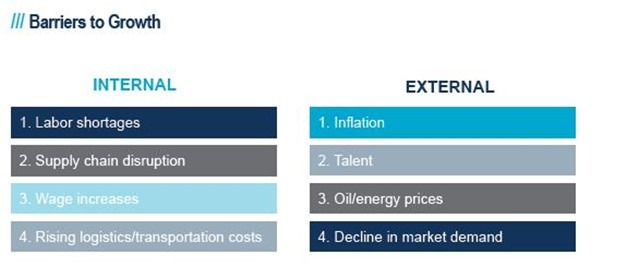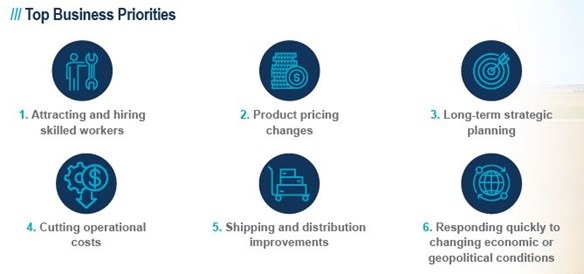Faced with disruption, manufacturers and distributors have proven to be very resilient, and the American workforce continues to pivot and adapt amidst adversity in most manufacturing environments. The industry will continue to face significant challenges including supply chain disruptions, worker shortages, and soaring costs through 2023 and into 2024. In this outlook, the top business challenges and priorities for manufacturing companies in the upcoming year are analyzed, and solutions are provided for how companies can achieve success.
Top Business Challenges for Manufacturing Companies

Source: LEA and LBMC Manufacturing Survey
The chart above provides insights into manufacturers’ top internal and external barriers to growth and top challenges for 2023. Based on these, manufacturers will take a closer look at their operational foundations, talent, and financial outlook. All industries are fighting for talent with the limited pool of candidates, which is due to a variety of reasons such as early retirements, voluntary turnover, COVID-19 testing and quarantine policies, or hybrid work offerings. With much of the workforce preferring remote work or a hybrid work environment, this trend has caused an issue for manufacturers since it is essential to have employees in person.
Labor shortages are a primary challenge, since manufacturers are operating now with a smaller crew than ever before and are having to heavily compete with higher wage and benefit offerings to retain talent. Leaders are hoping to attract potential employees through capital and operational investments. The goal is that these investments will counteract the current limited labor pool and improve efficiency.
Another main challenge impacting growth is inflationary pricing on the cost of raw materials, transportation, shipping, and energy. Immediate concerns are revenue delays, margin compression, and higher inventory costs. These often lead to disappointing operating results, bank covenant misses, and management turnover. As a result, there is significant time spent with clients and their stakeholders for resetting and getting up-to-speed.
The most successful LBMC clients in the manufacturing industry from 2020 to now are the ones that were decisive about swiftly making price changes and following up with multiple rounds as needed. On the other hand, those companies that waited on pricing changes often have suffered operating losses.
Top Business Priorities for Manufacturing Companies

Source: LEA x LBMC Manufacturing Survey
As expected, the number one challenge for manufacturers is also the number one priority, attracting and hiring skilled workers in addition to warehouse worker productivity. This is also likely due to staff fatigue, which can be mitigated by improving processes and workflows.
High priority for 2023 is to adjust pricing on products and services, and the priority of long-term strategic planning doesn’t fall far behind. Methods to cut operational costs, investing in updated manufacturing equipment and modernizing facilities appear to be integral. By now, manufacturers are keenly aware of the importance of maintaining agile supply chains and distribution channels when needing to quickly adjust to economic conditions. A disruption to their systems will quickly impact productivity, customer experience, and of course, revenue.
Prioritizing investments in machinery and equipment will also increase productivity and assist in mitigating labor shortages, operational costs, and inflation metrics. With inventory costs changing so much, manufacturers need to be adaptive and able to update systems with the actual cost in real time… or capture variances. Otherwise, their profit and loss (P&L) will be inaccurate.
E-commerce and digitalization are additional opportunities for manufacturers to help improve shipping and distribution. Customers want to buy from manufacturers just like they do as private consumers. Digitization can reduce vendor and customer downtimes by being able to track the data through new end-to-end visibility tools. On the other hand, there are oftentimes challenges of integrated systems, which can be slow and clunky due to necessary cybersecurity measures put in place to ensure safety and security.
Manufacturing and distribution companies are looking for redundancy in distribution, supply, and visibility to know if they are going to have a shortage or delay. In response, many companies are building up inventories, which will result in increased costs as well as inventory audit requirements in the coming year. Manufacturers will have to ensure they have multiple suppliers, digital tools, innovative efficiencies, and resilience with suppliers. They will also have to train employees to have supplier relationship management skills if they did not already have them. To support long-term growth strategies, manufacturers need to grow and retain/maintain agile leaders and systems.
Overall 2023 Outlook for Manufacturing Companies
Despite the challenges and areas to grow, manufacturers have a more confident outlook in their regional economies than in the global or national economy. As a result, manufacturers will focus on internal strategies and regional partnerships to continue to grow in 2023. Manufacturers are rethinking outsourcing and offshoring strategies by seeking additional supplies locally to maintain control and decrease lead times. The current climate of inflation and uncertain future is propelling manufacturers to strategically modernize plants and equipment. Consumers have and will continue to demand more durable and technology-driven products, putting pressure on manufacturers to invest their cash in plant modernization, hardware, and software in 2023.
Investing now in key capital improvements such as plant and equipment and ERP systems will help them prepare for an uncertain economy. Although they are more optimistic about their region than the national or global economy, respondents to the LEA/LBMC survey last fall are concerned about overcoming supply chain disruptions, fluctuating fuel and energy pricing, and – most importantly – staffing shortages. The challenges and priorities discussed overall tell manufacturers that to be successful in the upcoming year and current business environment, they must be innovative, resilient, and flexible.
